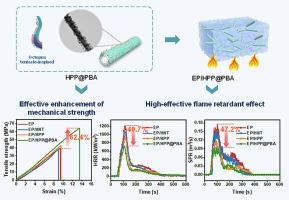受仿生章鱼触手结构启发的 HPP@PBA 纳米管工程:实现具有出色阻燃性和抑烟性能的机械增强环氧纳米复合材料
IF 5.8
2区 化学
Q1 POLYMER SCIENCE
引用次数: 0
摘要
开发兼顾阻燃性和机械性能的高性能环氧(EP)纳米复合材料一直是一项重大挑战。在这项工作中,成功构建了一种具有仿生章鱼触手结构的新型分层混合阻燃剂 HPP@PBA。由植酸(PA)、聚苯胺(PANI)和 CoFe-Prussian blue 类似纳米粒子(CoFe-PBA)组成的有机涂层能有效增强哈洛来石纳米管(HNTs)与 EP 基体之间的界面相互作用,促进机械互锁结构的形成。通过引入 5 wt% 的 HPP@PBA,复合材料的拉伸强度和冲击强度分别提高了 62.4% 和 38.7%。EP/HPP@PBA 还具有优异的阻燃和抑烟性能。EP 复合材料的极限氧指数(LOI)达到 33.0%,达到了 UL-94 V0 等级。锥形量热试验(CCT)表明,与纯 EP 相比,EP/HPP@PBA 的放热峰值(pHRR)、总放热(THR)、产烟峰值(pSPR)、总产烟量(TSP)和一氧化碳产烟峰值(COP)分别降低了 40.7%、34.0%、47.2%、42.5% 和 36.6%。此外,还系统地研究了 EP 复合材料中混合物的阻燃和机械增强机理。这项工作为制备多功能高性能 EP 纳米复合材料提供了一种可行的方法。本文章由计算机程序翻译,如有差异,请以英文原文为准。

Bionic octopus tentacle structure-inspired engineering of HPP@PBA nanotubes: Towards mechanically reinforced epoxy nanocomposites with outstanding flame retardancy and smoke suppression
Developing high-performance epoxy (EP) nanocomposites that balance flame retardancy and mechanical properties has been a significant challenge. In this work, a novel hierarchical hybrid flame retardant HPP@PBA with a bionic octopus tentacle structure was successfully constructed. The organic coating composed of phytic acid (PA) and polyaniline (PANI), and CoFe-Prussian blue analogue nanoparticles (CoFe-PBA), effectively enhances the interfacial interaction between halloysite nanotubes (HNTs) and the EP matrix, promoting the formation of a mechanical interlocking structure. By introducing 5 wt% HPP@PBA, the tensile strength and impact strength of the composites increase by 62.4 % and 38.7 %, respectively. EP/HPP@PBA also exhibits excellent flame retardancy and smoke suppression properties. The limiting oxygen index (LOI) of the EP composites reached 33.0 %, achieving the UL-94 V0 rating. Cone calorimetry test (CCT) shows that, compared with pure EP, the peak of heat release rate (pHRR), total heat release (THR), peak of smoke production rate (pSPR), total smoke production (TSP), and peak of carbon monoxide production (COP) of EP/HPP@PBA are reduced by 40.7 %, 34.0 %, 47.2 %, 42.5 %, and 36.6 %, respectively. Additionally, the flame retardant and mechanical enhancement mechanisms of hybrids in EP composites are systematically investigated. This work provides a feasible approach for preparing multifunctional high-performance EP nanocomposites.
求助全文
通过发布文献求助,成功后即可免费获取论文全文。
去求助
来源期刊

European Polymer Journal
化学-高分子科学
CiteScore
9.90
自引率
10.00%
发文量
691
审稿时长
23 days
期刊介绍:
European Polymer Journal is dedicated to publishing work on fundamental and applied polymer chemistry and macromolecular materials. The journal covers all aspects of polymer synthesis, including polymerization mechanisms and chemical functional transformations, with a focus on novel polymers and the relationships between molecular structure and polymer properties. In addition, we welcome submissions on bio-based or renewable polymers, stimuli-responsive systems and polymer bio-hybrids. European Polymer Journal also publishes research on the biomedical application of polymers, including drug delivery and regenerative medicine. The main scope is covered but not limited to the following core research areas:
Polymer synthesis and functionalization
• Novel synthetic routes for polymerization, functional modification, controlled/living polymerization and precision polymers.
Stimuli-responsive polymers
• Including shape memory and self-healing polymers.
Supramolecular polymers and self-assembly
• Molecular recognition and higher order polymer structures.
Renewable and sustainable polymers
• Bio-based, biodegradable and anti-microbial polymers and polymeric bio-nanocomposites.
Polymers at interfaces and surfaces
• Chemistry and engineering of surfaces with biological relevance, including patterning, antifouling polymers and polymers for membrane applications.
Biomedical applications and nanomedicine
• Polymers for regenerative medicine, drug delivery molecular release and gene therapy
The scope of European Polymer Journal no longer includes Polymer Physics.
 求助内容:
求助内容: 应助结果提醒方式:
应助结果提醒方式:


